Instruction
The Big Shift: How to master pressure and the golf transition using prior sports training
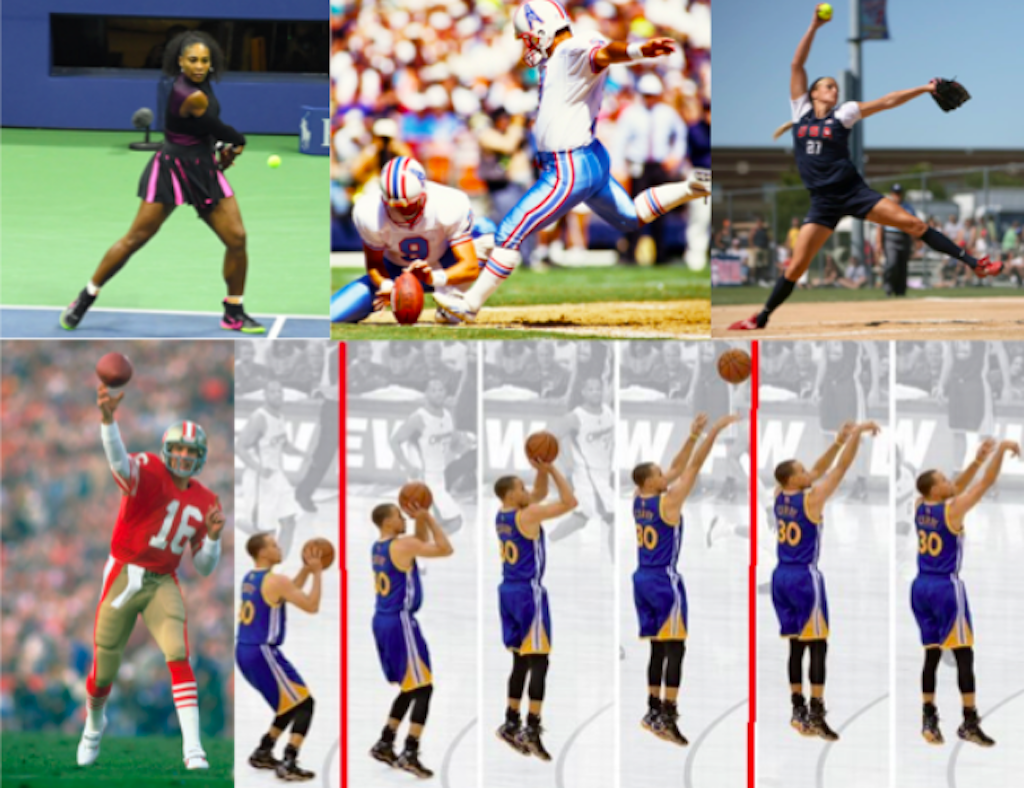
If you’re an #AverageJoeGolfer, work a day job, and don’t spend countless hours practicing, you might be interested in knowing that sports you played growing up, and even beer league softball skills, can be used to help you play better golf. We’re sure you’ve heard hockey players tend to hit the ball a mile, make the “best golfers”, while pitchers and quarterbacks have solid games, but baseball/softball hitters struggle with consistency. Did you know that a killer tennis backhand might help your golf game if you play from the opposite side? Dancers are way ahead of other athletes making a switch to golf because they understand that centeredness creates power and consistency much more efficiently than shifting all around, unnecessary swaying, or “happy feet.”
Lurking beneath fat shots, worm burners, and occasional shanks, are skillsets and motions you can pull from the old memory bank to apply on the golf course. Yes, you heard us right; your high school letterman jacket can finally be put to good use and help you improve your move. You just need to understand some simple adjustments different sports athletes need to make to be successful golfers.
In golf, shifting from your trailside into your lead side is what we’ll call the TRANSITION. Old School teachers refer to this motion, or shift, as “Foot Work”, New-Fangled-Techno-Jargon-Packed-Instruction uses “Ground Pressure/Force” to refer to the same concept. Don’t worry about the nomenclature; just know, as many GolfWRXers already do, that you must get your weight to your lead side if you want any chance at making solid and consistent contact. TRANSITION might be THE toughest motion in golf to master.
The good news for you is that TRANSITION happens in all other sports but in slightly different ways, depending on the sport. Golfers can more quickly learn TRANSITION, and speed up their swing learning process by understanding how prior sport experience can be applied to the golf swing.
[The basics of a solid golf move are; 1) you should have a SETUP that is centered and balanced, 2) you move your weight/pressure into your trail side during the TAKEAWAY and BACKSWING, 3) TRANSITION moves your weight/pressure back into your lead side, and 4) you FINISH with the club smashing the ball down the fairway. Okay, it’s not quite as easy as I make it sound, but hopefully our discussion today can relieve some stress when it comes time for you to start training your game.]
Baseball/Softball Hitters
Hitting coaches don’t like their hitters playing golf during the season, that’s a fact. The TRANSITIONS are too different, and if they play too much golf, they can lose the ability to hit off-speed pitches because their swing can become too upright. Golf requires an orbital hand path (around an angled plane) with an upright-stacked finish, while hitting requires batters to have a straight-line (more horizontal) hand path and to “stay back or on top of” the ball.
Now we apologize for the lack of intricate knowledge and terminology around hitting a baseball, we only played up through high school. What we know for sure is that guys/gals who have played a lot of ball growing up, and who aren’t pitchers struggle with golf’s TRANSITION. Hitters tend to hang back and do a poor job of transferring weight properly. When they get the timing right, they can make contact, but consistency is a struggle with fat shots and scooping being the biggest issues that come to mind.
So how can you use your star baseball/softball hitting skills with some adjustments for golf? Load, Stride, Swing is what all-good hitters do, in that order. Hitters’ issues revolve around the Stride, when it comes to golf. They just don’t get into their lead sides fast enough. As a golfer, hitters can still take the same approach, with one big adjustment; move more pressure to your lead side during your stride, AND move it sooner. We’ve had plenty of ‘a ha’ moments when we put Hitters on balance boards or have them repeat step drills hundreds of times; “oh, that’s what I need to do”…BINGO…Pound Town, Baby!
Softball/Baseball Pitchers, Quarterbacks, & Kickers
There’s a reason that kickers, pitchers, and quarterbacks are constantly ranked as the top athlete golfers and it’s not because they have a ton of downtime between starts and play a lot of golf. Their ‘day jobs’ throwing/kicking motions have a much greater impact on how they approach sending a golf ball down the fairway. It’s apparent that each of these sports TRAINS and INGRAINS golf’s TRANSITION motion very well. They tend to load properly into their trailside while staying centered (TAKEAWAY/BACKSWING), and they transfer pressure into their lead side, thus creating effortless speed and power. Now there are nuances for how to make adjustments for golf, but the feeling of a pitching or kicking motion is a great training move for golf.
If this was your sport growing up, how can you improve your consistency? Work on staying centered and minimizing “happy feet” because golf is not a sport where you want to move too much or get past your lead side.
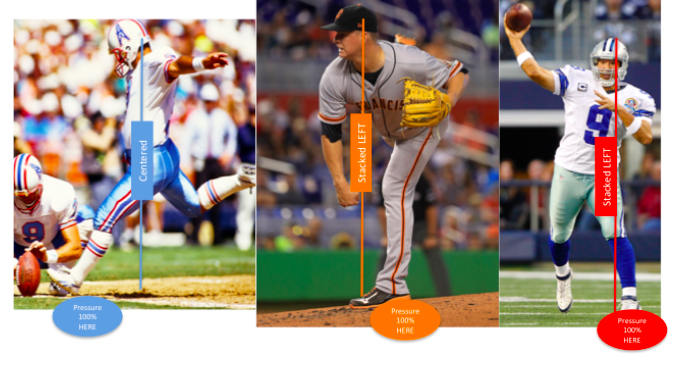
Dance
My wife was captain of her high school dance team, has practiced ballet since she was in junior high, and is our resident expert on Ground Pressure forces relating to dance. She has such a firm grasp on these forces that she is able to transfer her prior sports skill to play golf once or twice a year and still hit the ball past me and shoot in the low 100s; what can I say, she has a good coach. More importantly, she understands that staying centered and a proper TRANSITION, just like in Dance, are requirements that create stability, speed, and consistent motions for golf. Christo Garcia is a great example of a Ballerina turned scratch golfer who uses the movement of a plié (below left) to power his Hogan-esque golf move. There is no possible way Misty Copeland would be able to powerfully propel herself into the air without a proper TRANSITION (right).
Being centered is critical to consistently hitting the golf ball. So, in the same way that dancers stay centered and shift their weight/pressure to propel themselves through the air, they can stay on the ground and instead create a golf swing. Dancers tend to struggle with the timing of the hands and arms in the golf swing. We train them a little differently by training their timing just like a dance routine; 1 and 2 and 3 and…. Dancers learn small motions independently and stack each micro-movement on top of one another, with proper timing, to create a dance move (golf swing) more like musicians learn, but that article is for another time.
Hockey
Hockey is a great example of the golf TRANSITION because it mimics golf’s motions almost perfectly. Even a subtlety like the direction in which the feet apply pressure is the same in Hockey as in Golf, but that’s getting in the weeds a bit. Hockey players load up on their trailside, and then perform the TRANSITION well; they shift into their lead sides and then rotate into the puck with the puck getting in the way of the stick…this is the golf swing, just on skates and ice…my ankles hurt just writing that.
If you played hockey growing up, you have the skillsets for a proper golf TRANSITION, and you’ll improve much faster if you spend your time training a full FINISH which involves staying centered and balanced.
Now we didn’t get into nuances of each and every sport, but we tried to cover most popular athletic motions we thought you might have experience in in the following table. The key for your Big Shift, is using what you’ve already learned in other sports and understanding how you might need to change existing and known motions to adapt them to golf. If you played another sport, and are struggling, it doesn’t mean you need to give up golf because your motion is flawed…you just need to know how to train aspects of your golf move a little differently than someone who comes from a different sport might.
- LIKE48
- LEGIT13
- WOW3
- LOL1
- IDHT1
- FLOP34
- OB33
- SHANK46
Instruction
The Wedge Guy: The easiest-to-learn golf basic

My golf learning began with this simple fact – if you don’t have a fundamentally sound hold on the golf club, it is practically impossible for your body to execute a fundamentally sound golf swing. I’m still a big believer that the golf swing is much easier to execute if you begin with the proper hold on the club.
As you might imagine, I come into contact with hundreds of golfers of all skill levels. And it is very rare to see a good player with a bad hold on the golf club. There are some exceptions, for sure, but they are very few and very far between, and they typically have beat so many balls with their poor grip that they’ve found a way to work around it.
The reality of biophysics is that the body moves only in certain ways – and the particulars of the way you hold the golf club can totally prevent a sound swing motion that allows the club to release properly through the impact zone. The wonderful thing is that anyone can learn how to put a fundamentally sound hold on the golf club, and you can practice it anywhere your hands are not otherwise engaged, like watching TV or just sitting and relaxing.
Whether you prefer an overlap, interlock or full-finger (not baseball!) grip on the club, the same fundamentals apply. Here are the major grip faults I see most often, in the order of the frequency:
Mis-aligned hands
By this I mean that the palms of the two hands are not parallel to each other. Too many golfers have a weak left hand and strong right, or vice versa. The easiest way to learn how to hold the club with your palms aligned properly is to grip a plain wooden ruler or yardstick. It forces the hands to align properly and shows you how that feels. If you grip and re-grip a yardstick several times, then grip a club, you’ll see that the learning curve is almost immediate.
The position of the grip in the upper/left hand
I also observe many golfers who have the butt of the grip too far into the heel pad of the upper hand (the left hand for right-handed players). It’s amazing how much easier it is to release the club through the ball if even 1/4-1/2″ of the butt is beyond the left heel pad. Try this yourself to see what I mean. Swing the club freely with just your left hand and notice the difference in its release from when you hold it at the end of the grip, versus gripping down even a half inch.
To help you really understand how this works, go to the range and hit shots with your five-iron gripped down a full inch to make the club the same length as your seven-iron. You will probably see an amazing shot shape difference, and likely not see as much distance loss as you would expect.
Too much lower (right) hand on the club
It seems like almost all golfers of 8-10 handicap or higher have the club too far into the palm of the lower hand, because that feels “good” if you are trying to control the path of the clubhead to the ball. But the golf swing is not an effort to hit at the ball – it is a swing of the club. The proper hold on the club has the grip underneath the pad at the base of the fingers. This will likely feel “weak” to you — like you cannot control the club like that. EXACTLY. You should not be trying to control the club with your lower/master hand.
Gripping too tightly
Nearly all golfers hold the club too tightly, which tenses up the forearms and prevents a proper release of the club through impact. In order for the club to move back and through properly, you must feel that the club is controlled by the last three fingers of the upper hand, and the middle two fingers of the lower hand. If you engage your thumbs and forefingers in “holding” the club, the result will almost always be a grip that is too tight. Try this for yourself. Hold the club in your upper hand only, and squeeze firmly with just the last three fingers, with the forefinger and thumb off the club entirely. You have good control, but your forearms are not tense. Then begin to squeeze down with your thumb and forefinger and observe the tensing of the entire forearm. This is the way we are made, so the key to preventing tenseness in the arms is to hold the club very lightly with the “pinchers” — the thumbs and forefingers.
So, those are what I believe are the four fundamentals of a good grip. Anyone can learn them in their home or office very quickly. There is no easier way to improve your ball striking consistency and add distance than giving more attention to the way you hold the golf club.
More from the Wedge Guy
- The Wedge Guy: Golf mastery begins with your wedge game
- The Wedge Guy: Why golf is 20 times harder than brain surgery
- The Wedge Guy: Musings on the golf ball rollback
- LIKE85
- LEGIT13
- WOW6
- LOL1
- IDHT0
- FLOP4
- OB1
- SHANK8
Instruction
Clement: Stop ripping off your swing with this drill!

Not the dreaded headcover under the armpit drill! As if your body is defective and can’t function by itself! Have you seen how incredible the human machine is with all the incredible feats of agility all kinds of athletes are accomplishing? You think your body is so defective (the good Lord is laughing his head off at you) that it needs a headcover tucked under the armpit so you can swing like T-Rex?
- LIKE0
- LEGIT2
- WOW2
- LOL0
- IDHT0
- FLOP0
- OB0
- SHANK2
Instruction
How a towel can fix your golf swing

This is a classic drill that has been used for decades. However, the world of marketed training aids has grown so much during that time that this simple practice has been virtually forgotten. Because why teach people how to play golf using everyday items when you can create and sell a product that reinforces the same thing? Nevertheless, I am here to give you helpful advice without running to the nearest Edwin Watts or adding something to your Amazon cart.
For the “scoring clubs,” having a solid connection between the arms and body during the swing, especially through impact, is paramount to creating long-lasting consistency. And keeping that connection throughout the swing helps rotate the shoulders more to generate more power to help you hit it farther. So, how does this drill work, and what will your game benefit from it? Well, let’s get into it.
Setup
You can use this for basic chip shots up to complete swings. I use this with every club in my bag, up to a 9 or 8-iron. It’s natural to create incrementally more separation between the arms and body as you progress up the set. So doing this with a high iron or a wood is not recommended.
While you set up to hit a ball, simply tuck the towel underneath both armpits. The length of the towel will determine how tight it will be across your chest but don’t make it so loose that it gets in the way of your vision. After both sides are tucked, make some focused swings, keeping both arms firmly connected to the body during the backswing and follow through. (Note: It’s normal to lose connection on your lead arm during your finishing pose.) When you’re ready, put a ball in the way of those swings and get to work.

Get a Better Shoulder Turn
Many of us struggle to have proper shoulder rotation in our golf swing, especially during long layoffs. Making a swing that is all arms and no shoulders is a surefire way to have less control with wedges and less distance with full swings. Notice how I can get in a similar-looking position in both 60° wedge photos. However, one is weak and uncontrollable, while the other is strong and connected. One allows me to use my larger muscles to create my swing, and one doesn’t. The follow-through is another critical point where having a good connection, as well as solid shoulder rotation, is a must. This drill is great for those who tend to have a “chicken wing” form in their lead arm, which happens when it becomes separated from the body through impact.
In full swings, getting your shoulders to rotate in your golf swing is a great way to reinforce proper weight distribution. If your swing is all arms, it’s much harder to get your weight to naturally shift to the inside part of your trail foot in the backswing. Sure, you could make the mistake of “sliding” to get weight on your back foot, but that doesn’t fix the issue. You must turn into your trial leg to generate power. Additionally, look at the difference in separation between my hands and my head in the 8-iron examples. The green picture has more separation and has my hands lower. This will help me lessen my angle of attack and make it easier to hit the inside part of the golf ball, rather than the over-the-top move that the other picture produces.


Stay Better Connected in the Backswing
When you don’t keep everything in your upper body working as one, getting to a good spot at the top of your swing is very hard to do. It would take impeccable timing along with great hand-eye coordination to hit quality shots with any sort of regularity if the arms are working separately from the body.
Notice in the red pictures of both my 60-degree wedge and 8-iron how high my hands are and the fact you can clearly see my shoulder through the gap in my arms. That has happened because the right arm, just above my elbow, has become totally disconnected from my body. That separation causes me to lift my hands as well as lose some of the extension in my left arm. This has been corrected in the green pictures by using this drill to reinforce that connection. It will also make you focus on keeping the lead arm close to your body as well. Because the moment either one loses that relationship, the towel falls.


Conclusion
I have been diligent this year in finding a few drills that target some of the issues that plague my golf game; either by simply forgetting fundamental things or by coming to terms with the faults that have bitten me my whole career. I have found that having a few drills to fall back on to reinforce certain feelings helps me find my game a little easier, and the “towel drill” is most definitely one of them.
- LIKE12
- LEGIT2
- WOW2
- LOL0
- IDHT0
- FLOP2
- OB0
- SHANK8
-

 19th Hole1 week ago
19th Hole1 week agoDave Portnoy places monstrous outright bet for the 2024 Masters
-

 19th Hole3 weeks ago
19th Hole3 weeks agoThings got heated at the Houston Open between Tony Finau and Alejandro Tosti. Here’s why
-

 19th Hole1 week ago
19th Hole1 week agoTiger Woods arrives at 2024 Masters equipped with a putter that may surprise you
-

 19th Hole2 weeks ago
19th Hole2 weeks agoReport: Tiger Woods has ‘eliminated sex’ in preparation for the 2024 Masters
-

 19th Hole4 days ago
19th Hole4 days agoTwo star names reportedly blanked Jon Rahm all week at the Masters
-

 19th Hole4 days ago
19th Hole4 days agoNeal Shipley presser ends in awkward fashion after reporter claims Tiger handed him note on 8th fairway
-

 19th Hole3 days ago
19th Hole3 days agoReport: LIV Golf identifies latest star name they hope to sign to breakaway tour
-

 19th Hole2 weeks ago
19th Hole2 weeks agoAddiction, spinal fusion, and scam artists – Everything Anthony Kim revealed in candid interview with David Feherty



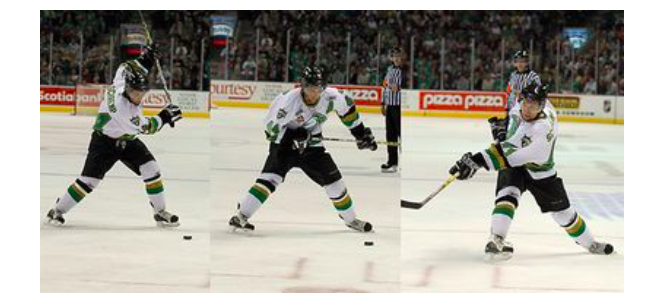
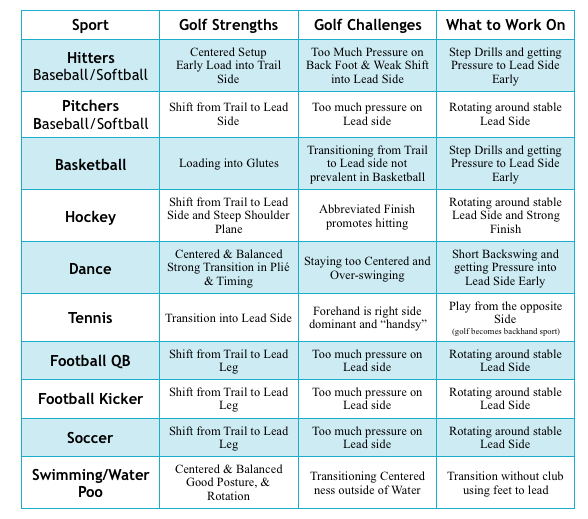












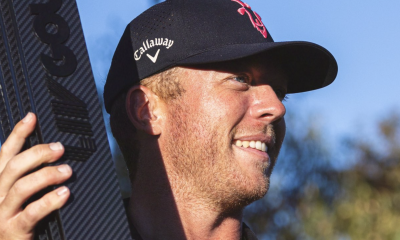














Lane Holt
Aug 22, 2019 at 9:22 pm
Mr.Strube,
You are correct . If I told a 15 hdcp to HIT with his hands he would definitely perform as you stated- poorly !. However, I would NEVER tell someone to HIT period ! HIT is a word that I never use to teach. I would tell them that they must teach their external brains ( their hands which are the only connection to the human structure ) to perform a task that is totally foreign to the Human genetic design.
These facts and truths have been around since 1992 and I have been trying to share this knowledge with those interested. The golf swing is not a natural action . I would recommend you check out Cortical Homunculus . This may give you insight to the Human design.
Respectfully,
Lane
MattStrube
Aug 23, 2019 at 12:22 pm
Thanks Mr. Holt, I’ll check it out. Always open to new ways of thinking about things and learning more. Really appreciate your comments. Matt
Lane Holt
Aug 21, 2019 at 7:32 am
Mr,Strube,
Nearly 50 % of our brain is dedicated to our * HANDS* , none to our feet! Our feet seem to perform quite well without our attention. Example , walking, running, etc; .
Teaching our hands to perform this task called the golf swing in a manner that is exactly opposite to the human genetic design is the key to a successful golf swing. Our HANDS control body movements and our body will always obey the hands.
The blueprint to a successful golf swing has been laid out for all to learn from, yet we still ignore it!
Best ,
Lane
Matt Strube
Aug 22, 2019 at 5:29 pm
Just saying/teaching/preaching that 50% of our brain is dedicated to our hands doesn’t get golfers better…Proper Training does, and it doesn’t start with the hands, Full Stop.
Additionally, the other point about what you’re saying depends on the individual’s own feels. , Feel vs. Real combined with Skill Matters a lot. If you tell a 15 handicapper to use his hands to hit a golf shot, you’ll get laid over sod, blocks, pull hooks, toppers, etc. They haven’t developed the 50% of the brain that you’re telling them to use. We see a lot of those types of folks, and they first and foremost need to learn how to move their body properly, full stop. Finally, it’s all about training the right parts of the body, hands, and arms, in the right order.
geohogan
Aug 22, 2019 at 7:56 pm
I bet Mr Holt can teach the complete golf swing, as Ben Hogan did it
in less than 30 minutes… its like dominoes when you start with the HANDS!
geohogan
Aug 23, 2019 at 8:09 am
50% of the motor cortex is devoted to hands by thousands of years of evolution, not be learning
or teaching by a golf instructors. Its in our DNA our genetic makeup as human beings.
Cant teach someone how to use a tool, if knowledge of the tool is incomplete.
geohogan
Sep 7, 2019 at 1:10 pm
https://ca.sports.yahoo.com/news/former-blue-jay-josh-donaldson-praises-current-young-star-bo-bichette-he-has-the-gift-020323584.html
I took one thing away from Josh when I talked to him the first time I met him and he said your hands and your lower body always have to be in synch,” Bichette recalled, according to Longley. “That’s something since that day (I’ve) tried to do.
What Josh Donaldson told Bo Bichette is remarkably similiar to what Mr Holt wrote.
Maybe he also knows that 50% of the motor cortex is about supporting the intent we have for the hands?
geohogan
Aug 19, 2019 at 1:50 pm
Balance is an autonomic mechanism to keep us upright.
Our subconscious knows what it needs to do in order to maintain
balance as we move 30-40 pounds (two arms and golf club) from one side of our body to the other.
its genetic pre programming.
Ground forces are reaction forces to intent to move weight of hands and arms. The specifics of the intent
determines how the balance mechanism reacts. Golf instructors know the correct intents or they do not.
If the latter, no amount of repetition or hard work will be successful.
MattStrube
Aug 20, 2019 at 11:31 am
Yes, balance is automatic, but I would say the opposite with regards to the reaction forces you mention (if I understand your comment correctly, I apologize if I misunderstood). The movement of the golf swing starts from the ground, with the feet, then moves up through the legs and then into the body’s core to rotate everything through the shot (oversimplification). The hands and arms do not move independently of the body.
geohogan
Aug 20, 2019 at 8:19 pm
With all due respect Matt, putting out my thoughts on the matter.
Ive been taught that the hands dominate the motor cortex. ie whatever our intent is for our hands
the body will support, subconsciously. its a survival mechanism in our genetics.
We consume food using our hands. Balance is a big part of that support.
Ive also been taught that the subconscious preprograms all our complex movements in fraction of time prior to the actual effort.
Understanding the above to be true, then is it not logical that our lower body , knowing in advance
where the weight of our hands and arms are intending to move, the subconscious balance mechanism will
brace in advance.
To all external observation it appears the lower body makes the first moves, true.
If teaching or learning, it makes all the difference if the above premise are true.
Most teach and most learn one body part a time(internal focus).
As a result IMO, proficiency at golf is by any measure a tedious and fruitless effort, resulting in diminishing interest in the game.
MattStrube
Aug 22, 2019 at 5:35 pm
Possibly, but why does every low handicapper lose spine angle and “hump” towards the ball when they use their hands and arms to hit a golf ball? If what you’re saying is true, shouldn’t the subconsciously be able to properly shift into their left side and move their lower body like el Tigre every time? If you don’t train golfers how to use their lower body, then they won’t improve by telling them “how” to use their hands better.
geo
Aug 22, 2019 at 6:43 pm
It sounds you think you have figured out how to train a person how to balance during a complex all body motion with bodies comprised of over 200 bones and 600 muscles, rather than letting the hundreds of billions of neurons in our brain and thousands of years of evolutionary learning in our DNA do its job.
Think about how arrogant and foolish that sounds when we have evolved to do that work subconsciously, perfectly.
Tiger is the poster boy for bad golf instruction, one body part at a time. His swing in 2000 was perfect
until the long line of instructors began f… with his swing and his body and his balance.
Golfers loose spine angle , hump the goat and all kinds of other contortions because their golf instructors dont know the correct INTENTION to teach.
Golfers are either provided with the PROPER INTENTION for use of their hands in the golf swing or if not the correct intention, golfers will suffer from evolutionary genetic tendency that causes all sorts of golf swing issues, not to mention the self inflicted damage to their bodies that will also result.
As Mr Holt wrote, the brain makes sure the intent of the hands is supported both by the entire body and the autonomic balance system. It is the evolutionary basis of survival for all humans, even golf instructors.
geohogan
Aug 22, 2019 at 6:57 pm
and to “hit’ with the hands is absolutely the worst intention and cause of the majority of golf swing problems.
GG
Aug 18, 2019 at 3:09 pm
I can teach the transition in 30 mins or less like dominoes.
Matt Strube
Aug 19, 2019 at 12:15 pm
If this is the Real GG, I’m sure you can…mad respect.
geohogan
Aug 24, 2019 at 8:38 pm
No doubt about it a perfect transition can be taught. What good is a perfect transition if the rest of the golf swing sucks.
Complex movement by humans is one continuous preprogram, set up by a singular intention,
not a patchwork of positions to piece together.
Larry
Aug 18, 2019 at 2:50 pm
Great article!
Cameron Wilson
Aug 16, 2019 at 3:10 pm
Shout out to Robbie Schremp.
Matt Strube
Aug 19, 2019 at 12:17 pm
Any chance you know his handicap? I bet he could hit the cover off a golf ball